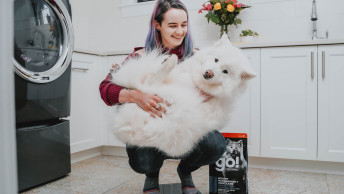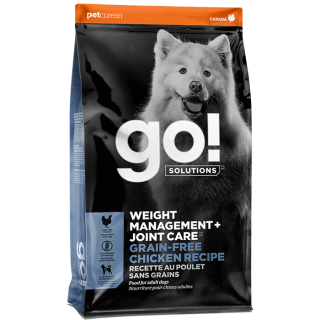March 24, 2022
Feeding the Overweight Dog

Just like us, dogs can also be overweight or obese. Obesity is a condition where excessive amount of body fat can be found, and this can negatively affect your dog’s health and mobility. A large percentage of the pet dog population in North America is reported to be overweight or obese. This is concerning as obesity and overweight can increase the risk of diseases such as diabetes, cancer, and osteoarthritis. These diseases might be scary and worrisome, but the good news is pet parents can prevent obesity in dogs. There are a variety of factors that can lead to obesity or overweight in dogs such as lack of exercise, overfeeding, feeding caloric-dense food or table scraps, and genetics.
If you think your dog maybe overweight, keep reading to learn some tips on how to feed them to achieve their ideal weight and keep them feeling great!
Is your dog overweight?
A dog is considered to be obese or overweight if it is 10 – 20% above its ideal body weight.1 However, the real question is, how can you tell if your dog is overweight or not? Luckily, we have some easy DIY at-home methods to share with you.
How to tell if your dog is overweight?
First, is the Look and Feel method.
Look: When looking at your dog from above, you should be able to see a slight indent in front of the hind legs, which create an hourglass shape. If you happen to spot a sausage shape instead, your dog might need to lose some weight.
Feel: Ribs and hips should be easily felt when you run your hands along your dog’s body without pressing too hard.
Second, check out our body score chart to help determine whether your dog needs to shed some weight or not.
Food Factor
As you have probably guessed it, diet plays a major factor in obesity or overweight in dogs. The ideal diet would provide the right balance of nutrients such as protein, energy, fat, and fiber to meet your dog’s requirements. However, in addition to diet types, diet portion also plays a role in contributing to overweight or obesity.
Portion control
Some pet parents might not be 100% sure on how much food to give their dogs. The amount of food needed by your dogs depends on their breed, activity level, age, climate, and health conditions. Additionally, there are a variety of dog food available in the market, each has different nutrient levels such as different energy content or protein levels. Therefore, to help pet parents determine how much food to feed, the feeding chart on the back of the bag is useful as a guide to achieve your dog’s ideal body weight.
Feeding the RIGHT diet
We are proud to introduce our new Go! Solutions Weight Management + Joint Care Grain-Free Chicken Recipe for dogs. This newly crafted diet is a grain-free and chicken recipe, which is formulated to maintain your dog’s ideal body weight and support healthy joints. Let’s learn more about what’s inside this diet!
L-carnitine is an important substance to support the optimal activities of enzymes in the metabolism of fatty acid. For humans, L-carnitine is commonly marketed as a weight loss supplement, but it has also been shown to be effective in weight management for dogs and cats. The mechanism of action of L-carnitine in weight loss is by burning fat into energy. When L-carnitine is deficient, less fatty acid will be burned and more fat will accumulate in lean tissues.2
Psyllium husk can be found in our Go! Solutions Weight Management + Joint Care diet. This ingredient is rich in fiber and can keep your dogs feeling full for longer; thus, they will tend to eat less. Psyllium is also known to have prebiotic benefits that stimulates the growth of beneficial intestinal bacteria, which helps keep constipation and diarrhea at bay.
Glucosamine and chondroitin are added to support joint health. As mentioned earlier, obesity or overweight increases the risk of bone and joint issues, because of increased wear and tear to support the excess weight.
Lower fat formula, compared to our other Go! Solutions recipes for dogs. The Weight Management + Joint Care recipe has been carefully formulated to include 38% less fat than our other dog food recipes to help manage your dog’s weight, while still meeting the complete and balanced nutrient requirements.

Recommended Solution
Controlled fat solutions to support a healthy weight
Maintaining your dog's mobility + healthy weight is one of the best ways to prevent health issues. Go! Solutions Weight Management + Joint Care’s blend of lean protein, healthy fats, and functional ingredients can help your dog stay in shape for life.
View product details
Weight loss and control
Now, what else can you do to help your dog lose some weight? First, you can slightly reduce or limit their food intake. Use a kitchen scale to ensure that you are feeding your dogs the right amount of food, if necessary. Second, exercise with them more! Go on for a longer hike, do some high-intensity play like fetch or flirt pole, or go for a run together. Third, opt for a weight control or controlled fat recipe such as our Go! Solutions Weight Management + Joint Care Recipe.
A good target for a healthy weight loss is approximately 1 – 2% per week. Weight loss that happens too fast and too drastic is unhealthy for your dogs, so make sure to keep track of your dog’s weekly progress by weighing them at home.
We understand that helping your dog to lose weight is not an easy task. It requires work and discipline from both you and your dog. So, don’t forget to reward yourself and your furry friend along the way with other activities to tighten your bond and always try to have fun.
American Animal Hospital Association (AAHA). 2020. Pet obesity is an epidemic. Accessed: http://www.aaha.org/publications/newstat/articles/2020-02/pet-obesity-is-an-epidemic/
Center, S.A., Harte, J., Watrous, D., Reynolds, A., Watson, T.D.G., Markwell, P.J., Millington, D.S., Wood, P.A., Yeager, A.E. and Erb, H.N. 2000. The clinical and metabolic effects of rapid weight loss in obese pet cats and the influence of supplemental oral L‐carnitine. J. Vet. Intern. Med. 14(6): 598-608.



